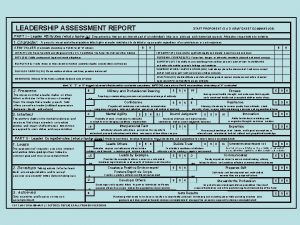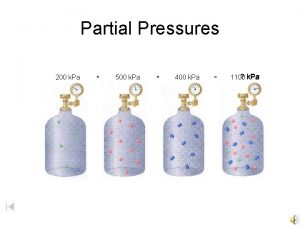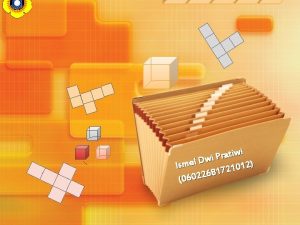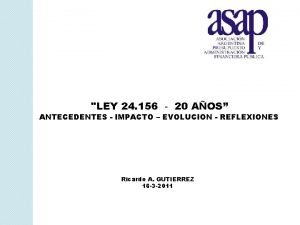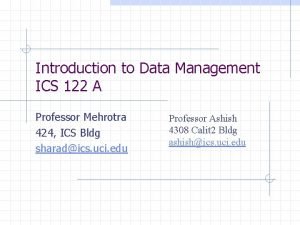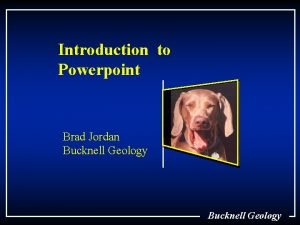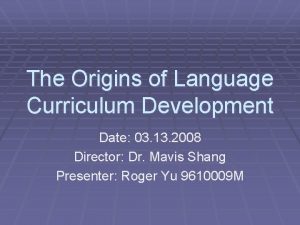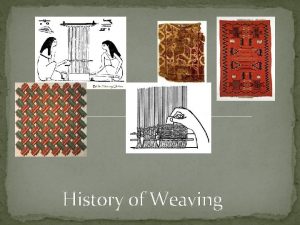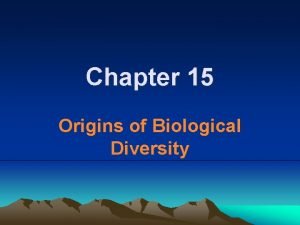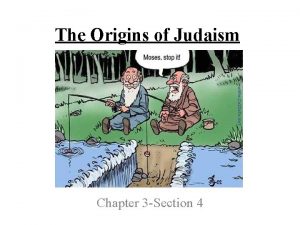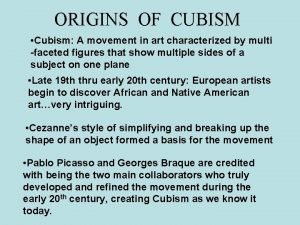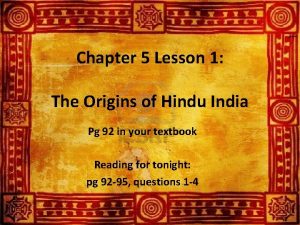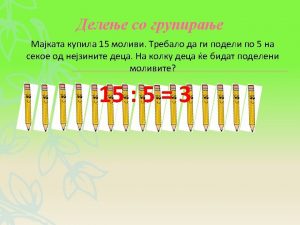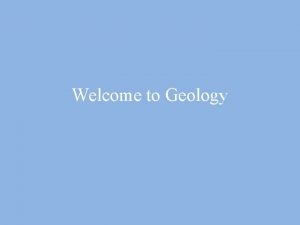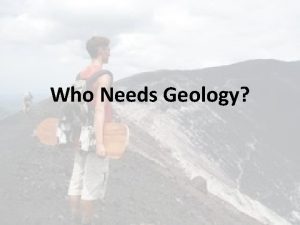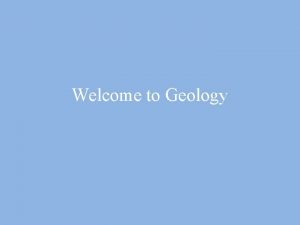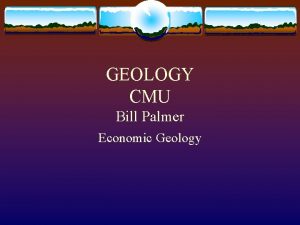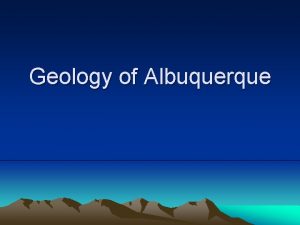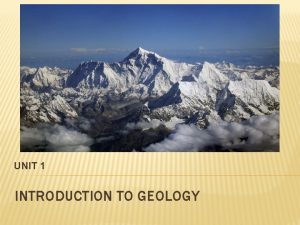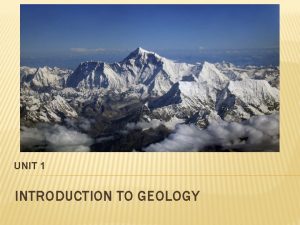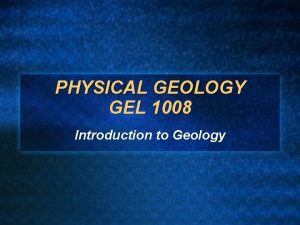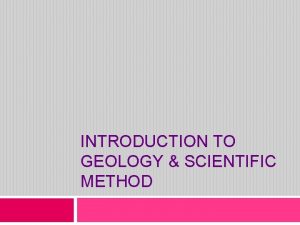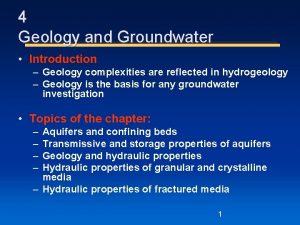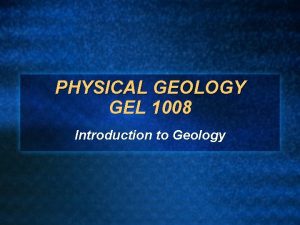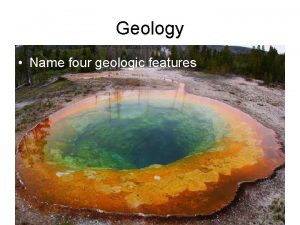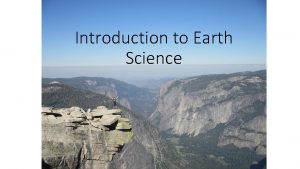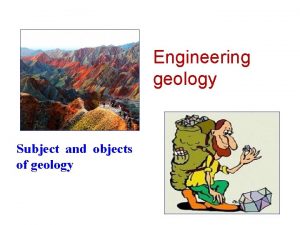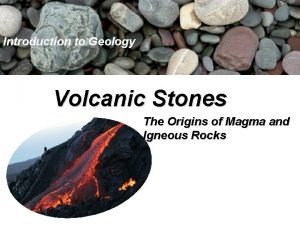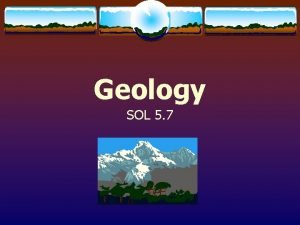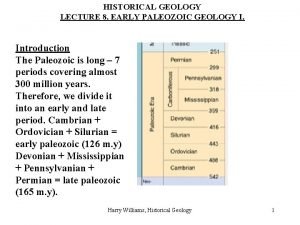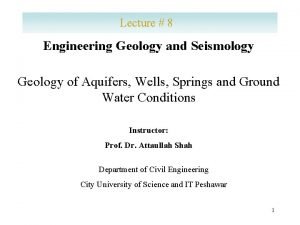Origins 156 Introduction to Geology What is Geology























































- Slides: 55

Origins 1/56

Introduction to Geology

What is Geology? • geo = Earth • ology = the study of • OR, a science that deals with the history of the Earth and its life, especially as recorded in rock (Merriam-Webster Online Dictionary)

What is Geology? • Physical geology - examines the materials composing Earth and seeks to understand the many processes that operate beneath and upon its surface • Historical geology - seeks an understanding of the origin of Earth and its development through time

Earth as a System Earth is a small, self-contained planet All parts of the Earth interact with one another Open vs. closed systems 5/56

The Four “Spheres” of the Earth Lithosphere Atmosphere Biosphere Hydrosphere 6/56

Atmosphere Hydrosphere Gases for respiration Circulation – mod temperature Weather Water for life Erosion of lithosphere Weather Biosphere Life! Respiration – O 2, CO 2 Decomposition - H 2 O, CO 2 Organic Matter Erosion of lithosphere Uses water Lithosphere Erosion → “salts” for ocean → soil for plants “Holds” water for future use 7/56

The Scientific Method Scientists assume the natural world is Consistent Predictable Our goal: Discover patterns in nature Use these patterns to make predictions 8/56

The Scientific Method 9/56

The Scientific Method Example: Scientist was looking at a nearby star Noticed the star dimming every so often HYPOTHOSIS: Dimming of star is due to the transect of a planet across the star TEST: (how would you test this? ) RESULT: (what do you think? ) 10/56

First Picture of Alien Planet Orbiting Sunlike Star? September 15, 2008—An image released today of a distant star and its potential planetary companion could go down in history as the first picture of a planet outside our solar system orbiting a sunlike star. The possible planet—a hot, young body (upper left) about eight times more massive than Jupiter—sits roughly 330 times as far from its host star as Earth is from the sun. The pair lies about 500 light-years from Earth. source 11/56

This image shows the newly discovered planet, Fomalhaut b, orbiting its parent star, Fomalhaut. Astronomers have calculated that Fomalhaut b completes an orbit around its parent star every 872 years. The white dot in the center of the image marks the star's location. Credit: NASA, ESA, P. Kalas, J. Graham, E. Chiang, E. Kite (University of California, Berkeley), M. Clampin (NASA Goddard Space Flight Center), M. Fitzgerald (Lawrence Livermore National Laboratory), and K. Stapelfeldt and J. Krist (NASA Jet Propulsion Laboratory) 12/56

What Is Oceanography? The process of discovering unifying principles in data obtained from the ocean, its associated life forms, and the bordering lands. Science is a systematic process of asking questions about the observable world and then testing the answers to those questions. 13/56

ORIGINS & THE FORMATION OF THE UNIVERSE 14/56

In the beginning. . . There was the “Big Bang” Incandescent gasses, no matter yet Eventually, cooled enough to form simple elements (H+, He) Stars formed, then died (supernovae) Why Does a Star Explode? 15/56

X-Rays from the Cat's Eye Nebula Credit: X-ray: NASA/CXC/SAO; Optical: NASA/STSc. I (source) Gas and Dust of the Lagoon Nebula Credit & Copyright: Fred Vanderhaven (source) 16/56

Hubble Observes Infant Stars in Nearby Galaxy January 8, 2007 12: 20 PM This new image taken with NASA's Hubble Space Telescope depicts bright, blue, newly formed stars that are blowing a cavity in the center of a star-forming region in the Small Magellanic Cloud. source 17/56

The Nebular Hypothesis Exploding star creates incandescent cloud of gasses & elements (aka a nebula) Nebula begins to rotate 18/56

The Nebular Hypothesis Gravity concentrates matter towards the center, forms a “proto-star” Dust-sized particles begin to smash together to form larger particles 19/56

An artist's conception shows the disk of dust and gas surrounding a young, whirling star. A new study suggests that turbulence helps, not hinders, such dust coalesce into planets by providing vortices where material can gather and grow. Source / Image courtesy NASA/JPL-Caltech 20/56

A still image from an artist's animation shows a pulsar—the rapidly rotating core of a dead massive star—surrounded by a disk of debris from the star's explosion. Scientists announced today that they found such a disk around a pulsar 13, 000 light-years from Earth and that the debris could eventually clump together to form planets. Source / Image courtesy NASA/JPL-Caltech 21/56

The Nebular Hypothesis As particles continue to collide with one another, they generate friction & heat Heat makes the particles melt and fuse together Larger and larger particles coalesce 22/56

The Nebular Hypothesis All planets formed via the accretion of particles Initially: Larger than they are today Homogeneous in composition Molten rock 23/56

As the heliosphere plows through interstellar space, a bow shock forms, much as forms in front of a boulder in a stream. magnetic "foam zone. " Termination Shock: Where the solar wind meets the interstellar wind. formed by the solar wind Heliosheath: The point where the solar wind slows abruptly, becoming denser and hotter. Sources: 1, 2, 3, 4 Heliopause: The boundary between solar wind and interstellar wind 24 / 63

The Scale of the Heliosphere and Nearby Galactic Neighborhood source 25/56

The solar system Why is the asteroid belt here? 26/56

4. 6 5 4 3 2 1 0 Billions of years before present PROTO-EARTH Thin, hard shell Molten inside LOTS of volcanic activity Outgassing formed first atmosphere Image source 28/56

4. 6 5 4 3 2 1 0 Billions of years before present PROTO-EARTH Particles still whizzing about the solar system Meteor impacts add material and heat to the planet Image source 29/56

4. 6 5 4 3 2 1 0 Billions of years before present Formation of our Moon Something the size of Mars collided with Earth 1. Object got stuck inside Earth 2. Debris encircled the Earth, eventually formed our moon Quick. Time animation 30/56

The grazing impact of a Mars-size body with the proto-earth more than four billion years ago is believed to have led to the formation of our moon. Artwork by Joe Tucciarone, commissioned by Astronomy magazine. 31/56

Time series of a Moon-forming impact simulation From the following article: Origin of the Moon in a giant impact near the end of the Earth's formation Robin M. Canup and Erik Asphaug Nature 412, 708 -712(16 August 2001) doi: 10. 1038/35089010 32/56

4. 6 5 4 3 2 1 0 Billions of years before present Formation of the Solar System (revisited) So, NOW what do you think caused the formation of the asteroid belt? 33/56

4. 6 5 4 3 2 1 0 Billions of years before present Formation of our Moon Evidence? 1. Our core is very large 2. Similar composition to iron meteorites 3. Moon is similar in composition to Earth 34/56

4. 6 5 4 3 2 1 0 Billions of years before present Formation of Layers within Earth Radioactive elements + Thermal contraction = Density stratification 35/56

4. 6 5 4 3 2 1 0 Billions of years before present Formation of Layers within Earth 36/56

4. 6 5 4 3 2 1 0 Billions of years before present Formation of our Atmosphere First atmosphere formed from outgassing Solar radiation stripped away initial atmospheres (also blew away remains of nebular gases) 37/56

4. 0 5 4 3 2 1 0 Billions of years before present Formation of our Oceans Outgassing formed hot clouds Eventually cooled, first (hot) rains fell Then what? 38/56

4. 0 5 4 3 2 1 0 Billions of years before present Formation of our Oceans Rains: Cooled the surface of Earth Began to erode the surface rocks Formed first oceans Rains may have lasted as long as 25 million years. Water may have covered the Earth’s surface for 200 m. y. ! 39/56

4. 0 5 4 3 2 1 0 Billions of years before present Formation of our Oceans Erosion of surface rocks: “locked” CO 2 into rocks Formed first salts in the oceans Ocean salinity nearly constant over past 4 billion years 40/56

41/56

3. 5 5 4 3 2 1 0 Billions of years before present Formation of our Atmosphere (revisited) Atmosphere began to change towards present due to: ü Breakdown of crust into sediments to form ROCKS How did this happen? ü Release of oxygen by the ancestors of green plants (2 billion years ago) 42/56

3. 5 5 4 3 2 1 0 Billions of years before present Origins of Life on Earth Hypothesized that life began in oceans Evidence: 1. All KNOWN organisms need water to survive 2. All of the earliest fossils are found in marine rocks 43/56

Twin “Black Smokers” source / Photograph by Emory Kristof Pale pink eelpout fish , white brachyuran crabs and blood-red tube worms source / Photograph by Emory Kristof White brachyuran crab source / Photograph by Emory Kristof 44/56

3. 5 5 4 3 2 1 0 Billions of years before present Earliest Lifeforms Cyanobacteria from NW Australia (3. 4 – 3. 5 b. y. o) 45/56

3. 5 5 4 3 2 1 0 Billions of years before present Earliest Lifeforms Stromatolites: colonial structures formed by cyanobacteria and other microbes 46/56

Modern stromatolites, Shark’s Bay Australia, and a 2. 2 billion year old fossil stromatolite from Michigan 47/56

Paleodictyon Flash website 48/56

The Origins of Life 1953 – Stanley Miller 49/56

3. 5 5 4 3 2 1 0 Billions of years before present Origins of Life on Earth Alternative Hypothesis: Recent research now suggests that simple organic compounds were brought to Earth on comets, meteors, and asteroids which crashed into the Earth during its birth. 50/56

Origins of life – 3 Easy Steps! 1. Make organic molecules (see Miller) 2. Replicate self 3. Metabolism Minerals from Black Smokers; bacteria chemosynthesize minerals; tube worms eat bacteria 51/56

2. 0 5 4 3 2 1 0 Billions of years before present Formation of our Atmosphere (revisited, again) Oceans + Photosynthesis = increase in O 2 1. About 2 billion years ago, sufficient O 2 in atmosphere to oxidize (rust) rocks 2. Ozone (O 3) builds up in atmosphere 3. Protects Earth’s surface from ultraviolet solar radiation 52/56

Event Earliest man Dinosaurs end Years before present 2 – 5 million 65 million Dinosaurs begin 240 million First land animals 370 million First land plants 430 million Lots of hard-shelled fossils 580 million Free atmospheric O 2 Earliest known life Oldest preserved rocks 2 billion 3. 5 billion 4 billion Earth forms 4. 6 billion Universe Forms 15 billion 53/56

The Earth Today • Our planet is a dynamic place – Plate tectonics – Erosion – Interaction between the Atmosphere and Oceans = weather

Goal of this Class • Identify major rock types and minerals • Understand the concept of plate tectonics • Understanding of Earth processes such as: – – – Mass Wasting Earthquakes Volcanoes Running water & groundwater Glaciations

~ End ~ 56/56
 Cadet leadership assessment card
Cadet leadership assessment card Factors of 156
Factors of 156 Leadership assessment report
Leadership assessment report Artigo 156 cc
Artigo 156 cc 98 156 chia 4 63
98 156 chia 4 63 Scoala156
Scoala156 600 e yuvarlanan en büyük sayı
600 e yuvarlanan en büyük sayı The partial pressure of oxygen was observed to be 156 torr
The partial pressure of oxygen was observed to be 156 torr 156+232
156+232 Perhatikan bangun berikut luas alas 196 cm
Perhatikan bangun berikut luas alas 196 cm Art 156 ctn
Art 156 ctn Ley 24 156
Ley 24 156 Architectural digest n 156 ddl
Architectural digest n 156 ddl 29cfr1910.156
29cfr1910.156 Introduction to geology ppt
Introduction to geology ppt Sociolgist
Sociolgist Grammar selection and gradation
Grammar selection and gradation Magic of kefir
Magic of kefir Describe peeta's injuries
Describe peeta's injuries Historical origins of the health belief model
Historical origins of the health belief model Rastafarian origins
Rastafarian origins Cwv origins assignment
Cwv origins assignment Origins of the cold war
Origins of the cold war Origins of the cold war
Origins of the cold war Origin of weaving
Origin of weaving Judo origin
Judo origin Basic tennis rules
Basic tennis rules Gastroncnemius
Gastroncnemius The study of word origins is
The study of word origins is Sikhism place of origin
Sikhism place of origin Earl bakken quotes
Earl bakken quotes Chapter 15 origins of biological diversity answers
Chapter 15 origins of biological diversity answers Origins of theatre
Origins of theatre Datagram network and virtual circuit network
Datagram network and virtual circuit network What was the real macbeth like
What was the real macbeth like Chapter 3 section 4 the origins of judaism answer key
Chapter 3 section 4 the origins of judaism answer key Origins of cubism
Origins of cubism The origins and spread of christianity
The origins and spread of christianity Data nugget
Data nugget Hinduism founder/origins
Hinduism founder/origins Study of word origins
Study of word origins Define community development?
Define community development? Chapter 18 section 1 origins of the cold war
Chapter 18 section 1 origins of the cold war Origins of the cold war chapter 18 section 1
Origins of the cold war chapter 18 section 1 Is beowulf italicized
Is beowulf italicized Origins of american government vocabulary
Origins of american government vocabulary Introspection tutor2u
Introspection tutor2u Origins of cricket
Origins of cricket What god does hinduism believe in
What god does hinduism believe in Origin of species chapter 18 manhwa
Origin of species chapter 18 manhwa Characteristics of jazz dance
Characteristics of jazz dance Halloween has its origins in which ancient celtic festival
Halloween has its origins in which ancient celtic festival How do the origins of folk and popular culture differ?
How do the origins of folk and popular culture differ? The origins of progressivism chapter 9 section 1
The origins of progressivism chapter 9 section 1 Lesson 1 origins of hindu india answers
Lesson 1 origins of hindu india answers How do the origins of folk and popular culture differ
How do the origins of folk and popular culture differ


